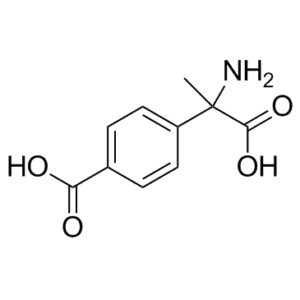This product is for research use only, not for human use. We do not sell to patients.

| Size | Price | Stock |
|---|---|---|
| 250mg | $1050 | Check With Us |
| 500mg | $1650 | Check With Us |
| 1g | $2475 | Check With Us |
Cat #: V3335 CAS #: 146669-29-6 Purity ≥ 98%
Description: (RS)-a-Methyl-4-carboxyphenylglycine [(RS)-MCPG] is a group I and II mGluR (metabotropic glutamate receptor) antagonist, it blocked TBS-induced shifts in both juvenile and neonatal hippocampal neurons.
References: Fiona Yeuk-Lun Choi, et al. The effects of (RS)-MCPG on amphetamine-induced sensitization in neonatal rats.
Publications Citing InvivoChem Products
Product Promise

- Physicochemical and Storage Information
- Protocol
- Related Biological Data
- Stock Solution Preparation
- Quality Control Documentation
| Molecular Weight (MW) | 209.20 |
|---|---|
| Molecular Formula | C₁₀H₁₁NO₄ |
| CAS No. | 146669-29-6 |
| Storage | -20℃ for 3 years in powder formr |
| -80℃ for 2 years in solvent | |
| Solubility In Vitro | DMSO: ≥ 5mg/mLr |
| Water: N/Ar | |
| Ethanol: N/A | |
| SMILES Code | CC(C(O)=O)(N)C1=CC=C(C(O)=O)C=C1 |
| Synonyms | alpha-MCPG; (RS)-MCPG; alpha MCPG; (RS) MCPG; alphaMCPG; (RS)MCPG |
| Protocol | In Vitro | MCPG can block group I (mGluR1 and mGluR5) and group II receptors (mGluR2 and mGluR3) |
|---|---|---|
| In Vivo | Pretreatment with the low dose of (RS)-MCPG (25 nM; i.c.; daily; 5 days) significantly attenuates amphetamine-induced locomotor activity in 10-day-old male and female rats of Sprague-Dawley descent |
| Solvent volume to be added | Mass (the weight of a compound) | |||
|---|---|---|---|---|
| Mother liquor concentration | 1mg | 5mg | 10mg | 20mg |
| 1mM | 4.7801 mL | 23.9006 mL | 47.8011 mL | 95.6023 mL |
| 5mM | 0.9560 mL | 4.7801 mL | 9.5602 mL | 19.1205 mL |
| 10mM | 0.4780 mL | 2.3901 mL | 4.7801 mL | 9.5602 mL |
| 20mM | 0.2390 mL | 1.1950 mL | 2.3901 mL | 4.7801 mL |
This equation is commonly abbreviated as: C1 V1 = C2 V2
- (1) Please be sure that the solution is clear before the addition of next solvent. Dissolution methods like vortex, ultrasound or warming and heat may be used to aid dissolving.
- (2) Be sure to add the solvent(s) in order.




































